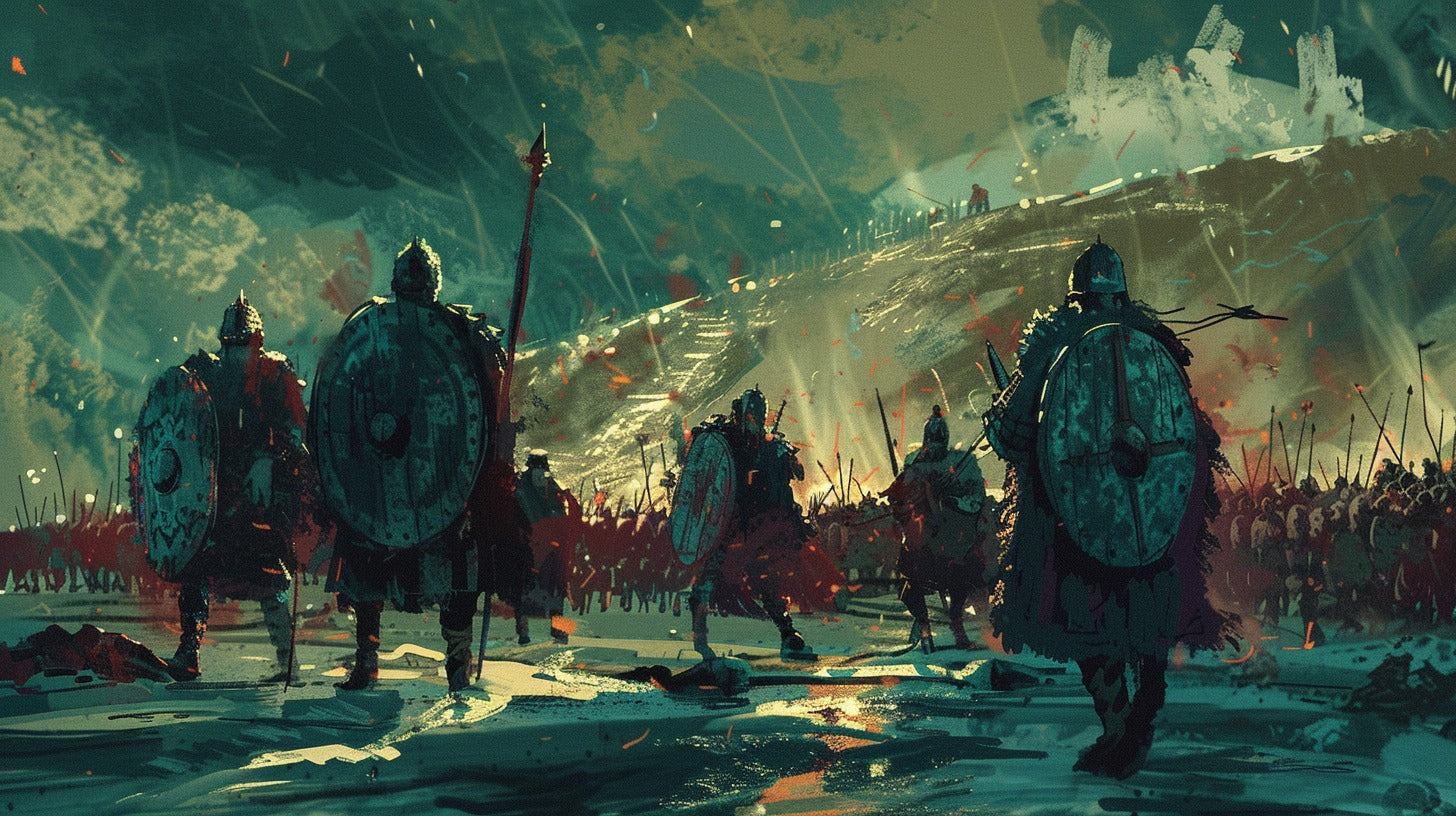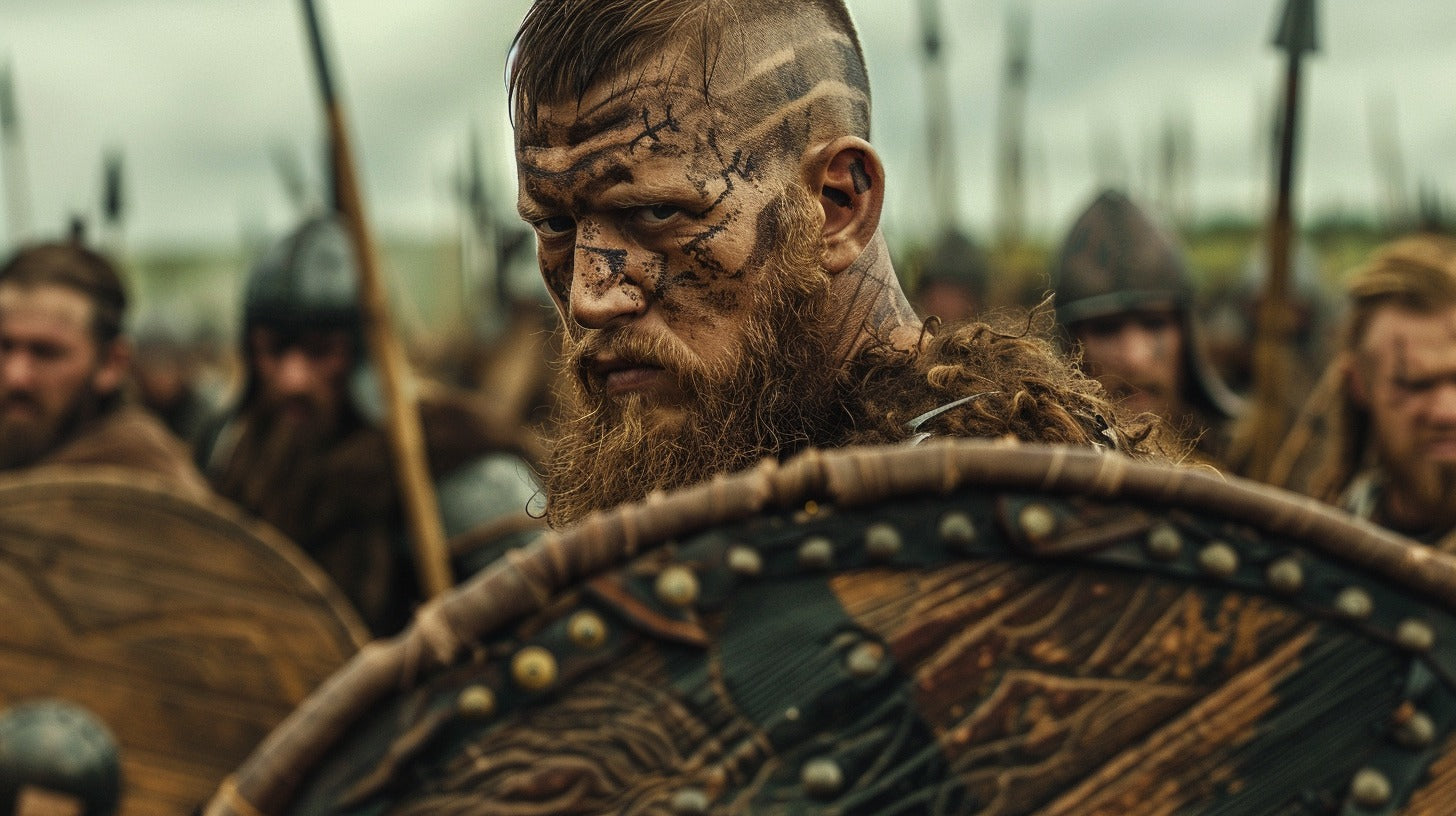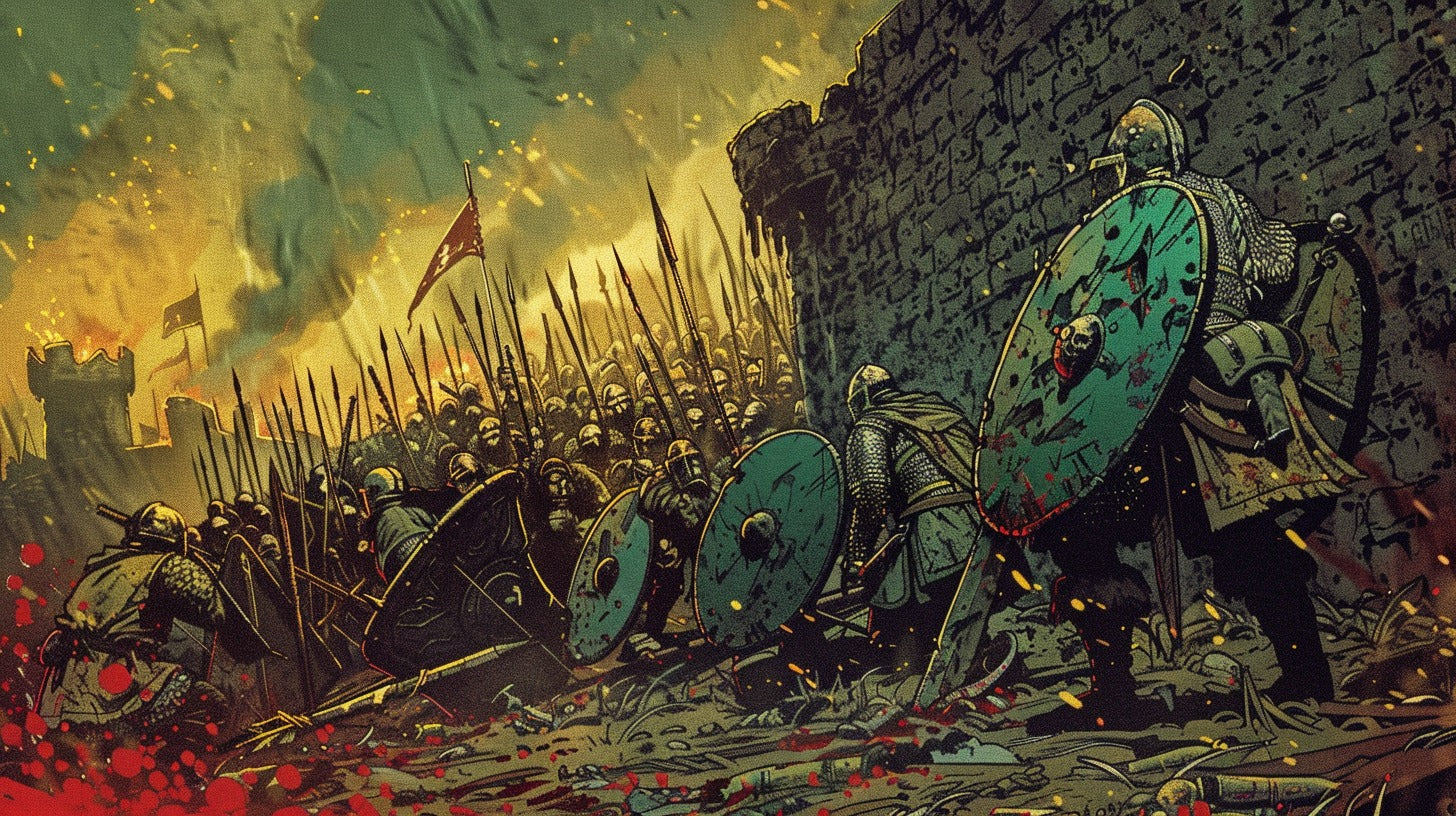
The Viking Invasion of Mercia: Blood, Steel, and the Forging of England
In the annals of history, few tales are as gripping as the Viking invasion of Mercia. It's a saga of ambition, violence, and the clash of cultures that would reshape the destiny of England. As we delve into this blood-soaked chapter of the past, we'll uncover the forces that drove the Norse warriors to Mercian shores and the desperate struggle of a kingdom fighting for its very survival.
The Gathering Storm: Norse Ambitions

Viking sword discovered in Repton, Mercia, believed to date back to the 9th century. Now located in the Derby Museum, showcasing the craftsmanship and weaponry of the Viking invaders / Photo: Roger from Derby, CC BY 3.0.
Warriors of the North: The Viking Psyche
Imagine, if you will, the fjords of Scandinavia, where the air is thick with salt and the promise of adventure. Here, in longhouses warmed by crackling fires, the Vikings dreamed of glory and riches. But what drove these fierce warriors to set their sights on distant shores?
The Viking psyche was a complex tapestry woven from threads of honor, ambition, and a thirst for the unknown. Their society valued strength and cunning, with tales of heroic deeds passed down through generations. For many, the narrow confines of their homeland felt like a cage, and the open sea beckoned with whispers of fame and fortune.
The Call of Conquest: Why Mercia?
But of all the lands that lay within reach of their dragon-prowed ships, why did Mercia draw the Viking gaze? The answer lies in the kingdom's reputation. Mercia was known throughout the Norse world as a land of plenty, its fertile fields and prosperous towns a tempting prize for any would-be conqueror.
Moreover, the political landscape of Anglo-Saxon England was fragmented, a patchwork of kingdoms often at odds with one another. To the shrewd Viking leaders, this disunity presented an opportunity ripe for exploitation. Mercia, for all its wealth, was vulnerable – and the wolves of the north were hungry.
Mercia: The Jewel of Anglo-Saxon Kingdoms

The Kingdom of Mercia (thick line) and the kingdom's extent during the Mercian Supremacy (green shading) / Photo: Rushton2010, CC BY-SA 3.0
A Land of Wealth and Promise
To understand the magnitude of the Viking invasion, we must first appreciate what Mercia was in the 9th century. Picture rolling hills clothed in ancient forests, interspersed with fields of golden wheat. Rivers, the lifeblood of trade, crisscrossed the land, their banks dotted with bustling towns.
Mercia was more than just a geographical entity; it was the beating heart of Anglo-Saxon England. Its wealth came not just from agriculture, but from a network of trade that stretched across Europe. Mercian craftsmanship, particularly in metalwork, was renowned, and its religious houses were centers of learning and culture.

Silver penny of Offa, King of Mercia (757-796), illustrating the intricate coinage and economic influence during his reign / Photo: Public Domain
The Mercian Royal House: Strength and Vulnerability
At the helm of this prosperous kingdom sat the Mercian royal house, a dynasty that traced its lineage back to the legendary Offa. They ruled from fortified burhs, their power upheld by a network of thegns and ealdormen. But even as they basked in the glory of Mercia's golden age, cracks were beginning to show in the foundations of their rule.
The succession was not always smooth, and rival claimants to the throne often lurked in the shadows, waiting for any sign of weakness. This internal strife would prove to be a critical vulnerability in the face of the coming storm. For as the saying goes, a house divided against itself cannot stand – and the Vikings were masters at exploiting such divisions.
The Great Heathen Army: Wolves at the Door

The Great Heathen Army, a coalition of Norse warriors, invaded Mercia in the late 9th century, capturing key strongholds and significantly altering the region's political landscape / Photo: Paganheim
The Sons of Ragnar: Leaders of the Host
In 865, the disparate raids that had long plagued English shores coalesced into something far more terrifying – the Great Heathen Army. At its head rode the sons of Ragnar Lodbrok, figures of legend whose names would be whispered in fear for generations to come.
Ivar the Boneless, Halfdan, and Ubba – each was a fearsome warrior in his own right, but together they were a force of nature. Their motivation was not merely plunder, but conquest. They came to carve out kingdoms, to write their names in the blood-soaked soil of England.
Tactics and Terrors: The Viking Way of War
The arrival of the Great Heathen Army marked a shift in Viking strategy. No longer content with hit-and-run raids, they now sought to establish permanent footholds. Their tactics were a blend of brute force and cunning, their longships allowing them to strike deep into the heart of Anglo-Saxon territories.
But it wasn't just their military prowess that made the Vikings such formidable foes. They brought with them a psychological warfare that struck terror into the hearts of their enemies. The sight of a Viking warband, shields interlocked, advancing behind a wall of gleaming spears, was enough to break the morale of many an Anglo-Saxon fyrd.
First Blood: The Fall of Nottingham

In 867, the Great Heathen Army besieged and captured Nottingham, a strategic stronghold in Mercia, marking a pivotal moment in their conquest and demonstrating their military prowess / Photo: Paganheim
Siege and Strife
The first major clash between the Great Heathen Army and Mercia came at Nottingham in 867. The town, perched strategically above the River Trent, was a key to controlling the kingdom's heartland. The Vikings, demonstrating their tactical acumen, struck swiftly and decisively.
The siege of Nottingham was a grueling affair. Picture the scene: Viking longships drawn up on the riverbank, their crews setting up camp around the town's walls. Inside, the defenders watched with growing dread as the noose tightened around them. The clash of steel, the roar of flames, the cries of the wounded – all these sounds echoed across the Mercian countryside, a grim overture to the symphony of war that was to come.
A Kingdom Shaken: Mercian Response
The fall of Nottingham sent shockwaves through the kingdom. King Burgred, realizing the gravity of the threat, called upon his ally Æthelred of Wessex for aid. It was a moment of reckoning for the Anglo-Saxon world – would old rivalries be set aside in the face of this existential threat?

Nottingham from the east / Painting: Jan Siberechts
The combined Mercian and West Saxon force that confronted the Vikings outside Nottingham was impressive, but ultimately indecisive. Neither side could gain the upper hand, and in the end, negotiations were opened. The Vikings withdrew – for a price. But this was no victory for Mercia. It was a harbinger of the chaos to come, a demonstration that the old order was crumbling in the face of this new, implacable foe.
The Danelaw: Viking Rule in Mercia
In the years that followed, much of eastern Mercia fell under Viking control. This region, along with other conquered territories, became known as the Danelaw – a land where Norse law and custom held sway. But what did this mean for the people who found themselves under Viking rule?

A reconstruction of a Viking from Repton in Mercia. This model is now in Derby Museum / Photo: Roger, CC BY-SA 2.0
Life in the Danelaw was a complex tapestry of conflict and coexistence. In some areas, Anglo-Saxon nobles retained their lands, paying tribute to their new Norse overlords. In others, Viking settlers established themselves, bringing with them their language, their beliefs, and their way of life. The England that emerged from this period would be forever changed, a fusion of Anglo-Saxon and Norse elements.
Resistance and Resilience
Yet even as large swathes of Mercia fell under the Danish yoke, the spirit of resistance burned bright. From the unconquered western regions, and even within the Danelaw itself, the Mercians fought on. Their struggle was not just for land or power, but for identity – for the very soul of their kingdom.
Guerrilla Warfare
The dense forests that still covered much of Mercia became a vital ally in this resistance. From these wooded fastnesses, Mercian warriors launched lightning raids on Viking settlements and patrols. The trees that had once sheltered game for the royal hunt now concealed a different kind of prey – one that bit back with steel and fire.
This guerrilla warfare took its toll on the invaders. The land they thought conquered proved to be filled with hidden dangers. Every shadow might conceal a Mercian warrior, every feast could be their last. The Vikings, masters of swift violence, found themselves mired in a grinding conflict against an enemy that refused to stand and fight on their terms.
Alliances Forged in Adversity
As the conflict wore on, new alliances were forged in the crucible of invasion. Mercia, once the dominant power among the Anglo-Saxon kingdoms, now turned to its southern neighbor Wessex for support. The Wessex king, Alfred the Great, recognized that the fate of all Anglo-Saxon kingdoms was intertwined. If Mercia fell, Wessex would surely be next.
This alliance would prove crucial in the years to come, culminating in victories like the Battle of Tettenhall in 910. Here, the combined forces of Mercia and Wessex dealt a significant blow to Viking power, proving that unified resistance could stem the tide of invasion.
Conclusion
The Viking invasion of Mercia was more than just a series of battles and political maneuvers. It was a crucible in which the future of England was forged. The kingdom that emerged from this tumultuous period was forever changed – culturally richer, politically more unified, but bearing the scars of a struggle that had pushed it to the brink of annihilation.
As we look back on this pivotal chapter in English history, we're reminded of the complex interplay of forces that shape nations. The Viking invasion was not simply a story of conquerors and conquered, but a catalyst for cultural exchange and political evolution. In the end, both Mercian and Viking left their mark on the land, contributing to the diverse tapestry that is modern England.
The saga of the Viking invasion of Mercia serves as a testament to the resilience of a people faced with overwhelming odds, and the unpredictable ways in which the currents of history can shape the destiny of nations. It's a reminder that even in our darkest hours, the seeds of future greatness may be sown.
FAQs
- How long did the Viking invasion of Mercia last?
The Viking invasion of Mercia wasn't a single event but a process that lasted several decades, from the first major incursions in the 860s to the establishment of the Danelaw in the early 10th century.
- What was the significance of the Danelaw?
The Danelaw represented areas of England under Viking control and influence. It led to significant cultural and linguistic changes, introduced new systems of law, and ultimately contributed to the diverse heritage of England.
- Who were the key figures in the Mercian resistance against the Vikings?
While King Burgred initially led the Mercian resistance, figures like Æthelred, Lord of the Mercians, and his wife Æthelflæd, known as the Lady of the Mercians, played crucial roles in defending against Viking incursions after Burgred's exile.
- How did the Viking invasion change Mercian society?
The invasion led to significant cultural and linguistic changes, introduced new systems of governance in areas under Viking control, and ultimately contributed to the political realignment that would lead to the unification of England.
- Did any Mercian traditions or institutions survive the Viking invasion?
Yes, many Mercian traditions and institutions survived, particularly in western Mercia which remained under Anglo-Saxon control. The Mercian dialect of Old English, certain legal customs, and local governance structures persisted and influenced the development of English society.








